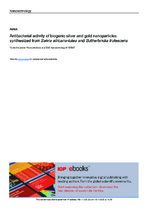| dc.description.abstract | Nanoparticles (NPs) synthesized using various chemical and physical methods are often cytotoxic which restricts their use in biomedical applications. In contrast, metallic biogenic NPs synthesized using biological systems such as plant extracts are said to be safer and their
production more cost effective. NPs synthesized from plants with known medicinal properties can potentially have similar bioactivities as these plants. It has been shown that Salvia africana-lutea (SAL) and Sutherlandia frutescens (SF) have antibacterial activities. This study
used water extracts of SAL and SF to produce biogenic silver NPs (AgNPs) and gold NPs (AuNPs). The antibacterial activity of AgNPs and AuNPs was tested against two pathogens (Staphylococcus epidermidis and P. aeruginosa). NP synthesis was optimized by varying the
synthesis conditions which include synthesis time and temperature, plant extract concentration, silver nitrate (AgNO3) concentration and sodium tetrachloroaurate (III) dihydrate (NaAuCl4 · 2H2O) concentration. The NPs were characterized using Ultraviolet-visible
(UV–vis) spectroscopy, dynamic light scattering, high-resolution transmission electron microscopy (HR-TEM), and Fourier transform infrared (FT-IR) spectroscopy. SAL was able to synthesize both Ag (SAL AgNP) and Au (SAL AuNP) nanoparticles, whilst SF synthesized Ag
(SF AgNP) nanoparticles only. The absorbance spectra revealed the characteristic surface plasmon resonance peak between 400–500 nm and 500–600 nm for AgNP and AuNP, respectively. HR-TEM displayed the presence of spherical and polygon shaped nanoparticles
with varying sizes whilst the Energy Dispersive x-ray spectra and selected area diffraction pattern confirmed the successful synthesis of the AgNPs and AuNPs by displaying the characteristic crystalline nature, optical adsorption peaks and lattice fringes. FT-IR spectroscopy
was employed to identify the functional groups involved in the NP synthesis. The microtitre plate method was employed to determine the minimum inhibitory concentration (MIC) of the NPs and the extracts. The water extracts and SAL AuNP did not have significant antibacterial
activity, while SAL AgNP and SF AgNP displayed high antibacterial activity. In conclusion, the data generated suggests that SAL and SF could be used for the efficient synthesis of antibacterial biogenic nanoparticles. | en_US |

